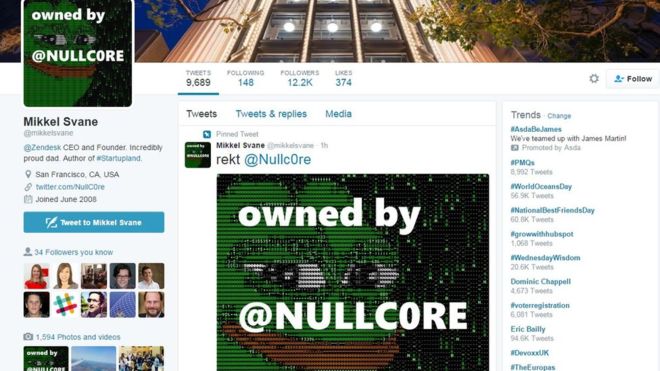
The chief executive of tech support firm Zendesk has become the latest high-profile figure to have his Twitter account hacked.
Mikkel Svane’s hijacked account had its ID image changed to that of a cartoon.
It follows similar attacks against accounts owned by Facebook’s Mark Zuckerberg, musicians Keith Richards, Katy Perry and Bon Iver and the model Kylie Jenner. All occurred over the last fortnight.
Zendesk played down the attack.
“This was an isolated incident that affected a personal Twitter account,” said a spokeswoman.
“No Zendesk systems or accounts were accessed. We were able to quickly identify and secure the impacted account.”
Customer relations
San Francisco-based Zendesk provides software to run its clients’ phone and email-based customer relations services, and says its takes “the most stringent” security measures.
Although there is no indication that the Twitter hack has threatened any of its other data, the breach is potentially embarrassing.
Zendesk’s clients include the NHS, L’Oreal and Vodafone. It was previously hacked in 2013, when some of its customers’ email addresses and other data was compromised.
Mr Svane’s account was restored within half an hour of the BBC notifying the firm of the attack.
Twitter has urged other users to take precautions.
“A number of other online services have seen millions of passwords stolen in the past several weeks,” a spokesman for Twitter said.
“We recommend people use a unique, strong password for Twitter. We detail other steps people can take to keep their accounts secure on our help centre.”
Other notable accounts to have been stolen in recent days include:
- the US National Football League (NFL)
- the band Tenacious D
- the singer Lana Del Rey
- the singer Cody Wilson
- the rapper Drake
- the Netflix chat show host Chelsea Handler
- the late Beatles guitarist George Harrison
- the late actor Ryan Dunn
Some security experts believe the attacks are related to a recent dump of LinkedIn logins sourced from a breach in 2012.
The hackers may be cross-referencing the list with other social media platforms to see which IDs still work.
“Many of us think this shows how infrequently people change their passwords and also the degree of password re-use that goes on,” commented Prof Alan Woodward from the University of Surrey.
Twitter began letting its members enable two-stage authentication last year, in which they have to type in a code texted to their phone in addition to their password when logging in.
But many users have not wanted to adopt this extra step.
“There’s not much more Twitter can do,” said Prof Woodward.
“This will continue to be an issue until we do away with passwords, which isn’t going to happen soon.”
BBC


























